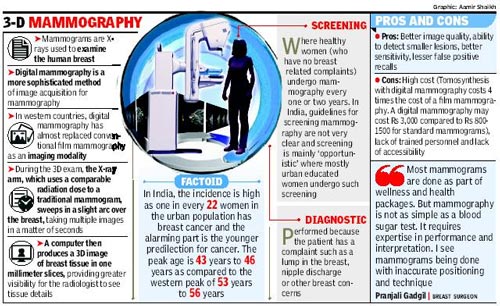Integrated 3D mammography, also known as tomosynthesis, improves breast-cancer detection as it can reduce false positive recalls, say experts. The diagnostic tool can reveal even a very small focus area of irregularity on the digital mammography images.
“Tomosynthesis is an advanced diagnostic tool designed for early detection of breast cancer. While standard mammography produces a flat image, tomosynthesis creates a three-dimensional rendering of the breast which results in greater accuracy, early breast cancer detection and a decrease in biopsies and recall rates,” said radiologist Ashish Atre of Star Imaging and Research Centre.
The tool helps perform mammography in patients without the worry of radiation risks. It also aids in adding information from previous studies without subjecting the patient to additional radiation, he added.
This technology came to the aid of fiftynine-year-old Pratibha, who had already undergone a surgery for the removal of the right breast (mastectomy), but had started experiencing abnormal discharge from the left breast.
Despite undergoing serial mammography evaluation every six months, her problem was persistent and no cause could be found. She was then advised to undergo tomosynthesis. This helped reveal an irregularity of just 6 mm in size on the digital mammography images.
As the cancer was detected very early, an organ conserving surgery could be performed, making a significant difference to the quality of her life.
“For patients who are less than 40 years of age and have dense breasts on mammography, tomosynthesis can be done for better appreciation of lesions,” said breast surgeon Anupama Mane.
Patients who have discordant clinical findings, imaging features and histological findings are usually advised to undergo an integrated 3D mammography.
“Tomosynthesis can give more clarity in such cases,” Mane said, adding that it is not recommended for routine screening purposes.
Medical oncologist Shona Nag said digital mammography is recommended for diagnosing problems and cases that are not picked up by routine mammography.
“It is indicated for highrisk cases with family history or likelihood of genetic mutations and also solving indeterminate mammography lesions. But it is certainly not a cost effective tool for screening.”
Another breast surgeon, Pranjali Gadgil, also vouched for the diagnostic strengths of digital mammogram. “I strongly suggest a digital mammogram when I need diagnostic imaging where I know that the patient has a breast mass, bloody nipple discharge, previous breast radiation or in patients with dense breasts.” She added that those who can afford it can also use this system in the screening mammography setting as there is certainly no downside compared to film mammography.
Gadgil, however, pointed out problems with mammography as it is done in the city right now. “Most mammograms are being done as ‘wellness packages’ ‘health packages’ etc. However mammography is not as simple as a blood sugar test, it requires considerable expertise in performance and interpretation. I commonly see mammograms being done with inaccurate positioning and technique, or worse even in women as young as 20 or 30 when they are clearly not needed,” she said.
Source
Times Of India
30 April 2014
Pune, India
Umesh Isalkar TNN







